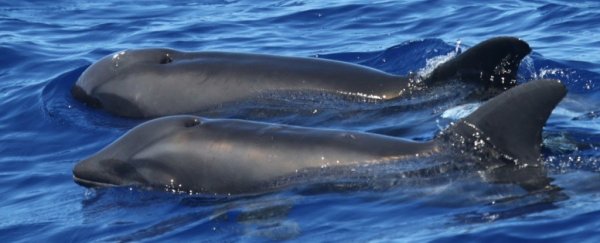A little bit of interspecies nookie has resulted in an unusual child that now lives in the waters off the Hawaiian island of Kauai.
According to a new genetic analysis, his dad was a rough-toothed dolphin and his mum was a melon-headed whale - the first ever known hybrid of its kind.
The cetacean was first spotted in August 2017, by researchers with the Cascadia Research Collective on a two-week field trip funded by the US Navy to document marine life around the Pacific Missile Range Facility ahead of a training course.
"We had the photos and suspected it was a hybrid from morphological characteristics intermediate between species," marine biologist Robin Baird told The Garden Island.
The team was able to obtain a biopsy, using a crossbow equipped with a special dart that prevents deep penetration and returns a skin sample.
This confirmed the animal's parentage - and the finding is really unusual, not just because it's the first known rough-toothed dolphin/melon-headed whale hybrid.
The melon-headed whale, which the researchers also observed hanging around during their expedition, is also relatively rare in the waters of Hawaii. There was one large pod, estimated to be somewhere between 200 and 300 individuals. In addition, they saw and tagged pantropical spotted dolphins, also rare in Hawaiian waters.
But there was also a perhaps greater anomaly. One melon-headed whale was also spotted chilling with a pod of rough-toothed dolphins. This, the researchers believe, could be the hybrid's mother, who is now living with her new family.
Before you go tie your head in knots wondering how a whale managed to successfully reproduce with a dolphin - it didn't. Like orcas, beluga whales and pilot whales, melon-headed whales are actually a species of dolphin, or delphinidae - and dolphins are a sub-family of whales to boot.
And, although rare, other dolphin hybrids are known, such as the offspring of a bottlenose dolphin and false killer whale (also delphinidae), called a wholphin, and the offspring of a beluga whale and a narwhal, called a narluga.
But an animal hybrid doesn't necessarily mean a new species - not even established hybrids, such as the mule. This is because such genetic hybrids are often infertile, or reproduce only with great difficulty, meaning they cannot produce viable offspring with their own kind.
But occasionally the factors required to create a new species do fall into place. A good example of hybridisation leading to a new species is the finches of Galapagos, where scientists recently observed finches becoming a new species in just two generations.
It's unknown whether this new animal - which the researchers named Steno bredanensis - could produce viable offspring, but in any case, one hybrid animal does not make a new species.
But a hybrid can also tell us something interesting about animal interactions. For instance, perhaps when the mother was looking for a mate, she was unable to find a suitable one among her own species.
The purpose of the field research was to ascertain how cetaceans use the area - what populations are present, and how they communicate. This is because naval activities, particularly those that use sonar, can disrupt their way of life - and commonly used cetacean frequencies can interfere with sonar.
The team will be heading back to the area in August to conduct further research - and hopefully catch another glimpse of Steno bredanensis.
You can find the team's report online here.
